Examining CSR: Starbucks, CSR Models, and Corporate Responsibility
VerifiedAdded on 2023/05/31
|16
|3929
|465
Essay
AI Summary
This essay provides an analysis of Corporate Social Responsibility (CSR) with a focus on Starbucks' CSR activities and a comparison of different CSR models. It begins with an introduction to CSR as an integral part of modern business operations, highlighting the importance of consumer loyalty and high-quality goods. The analysis delves into how Starbucks implements CSR activities to maintain a positive public image, referencing models such as Friedman's CSR model, the corporate citizen model, the triple bottom line, and Carroll's pyramid of responsibility. The essay discusses the benefits and potential drawbacks of CSR, emphasizing Starbucks' strategies in community involvement, environmental stewardship, and ethical sourcing. It also explores the economic, legal, ethical, and philanthropic responsibilities within Carroll's pyramid, linking them to Starbucks' practices, such as employee benefits and environmental initiatives. The essay concludes by reiterating the significance of CSR in organizational dynamics and its contribution to solving social problems.
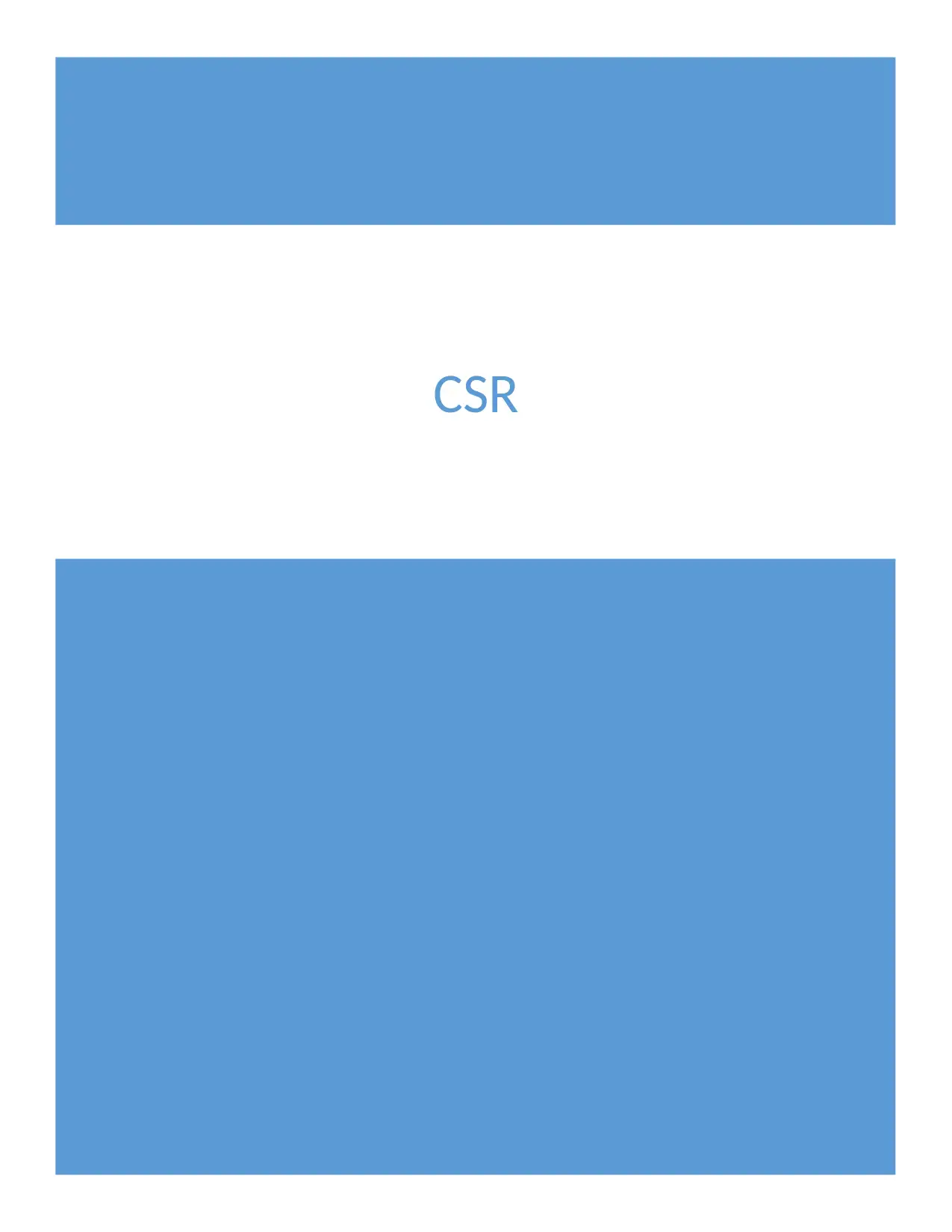
CSR
Paraphrase This Document
Need a fresh take? Get an instant paraphrase of this document with our AI Paraphraser
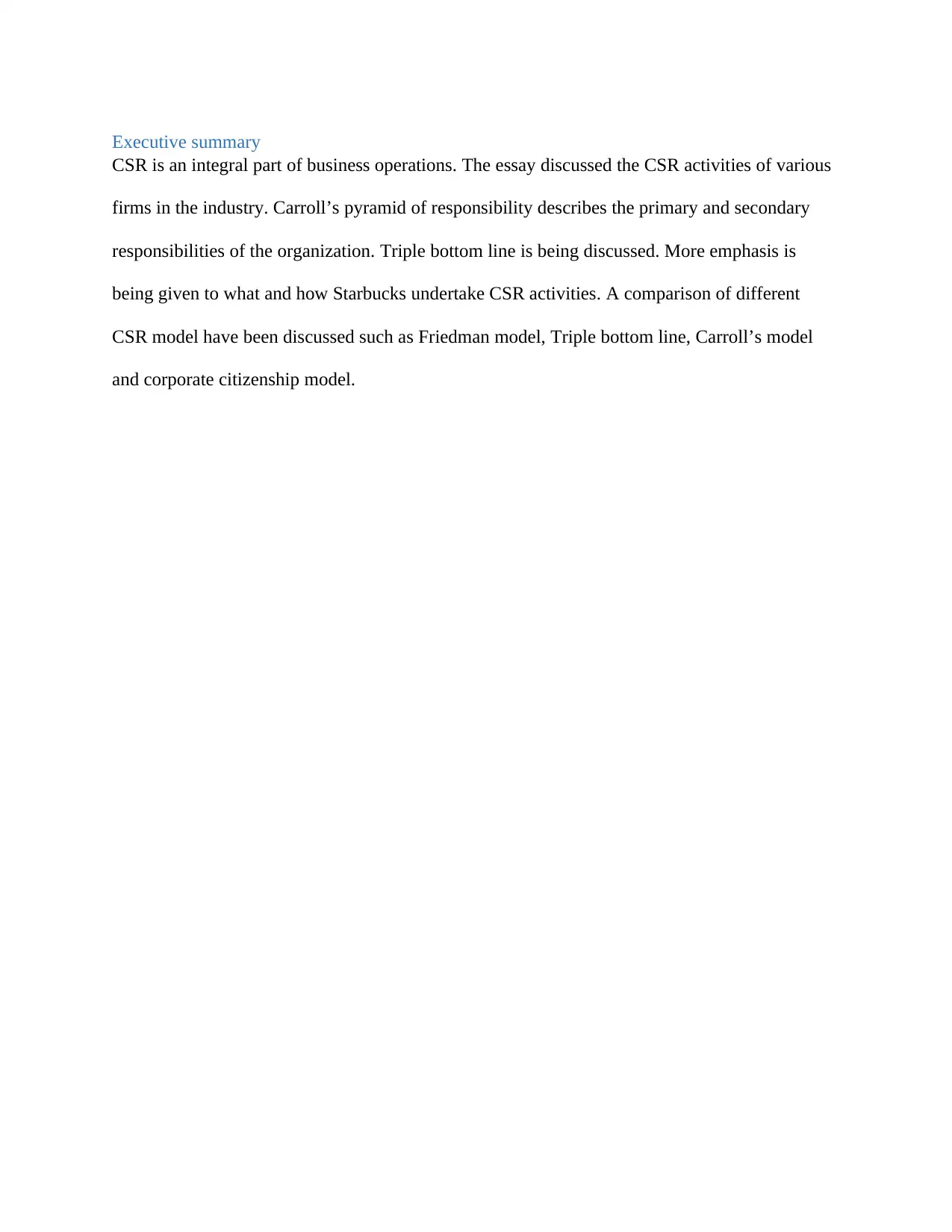
Executive summary
CSR is an integral part of business operations. The essay discussed the CSR activities of various
firms in the industry. Carroll’s pyramid of responsibility describes the primary and secondary
responsibilities of the organization. Triple bottom line is being discussed. More emphasis is
being given to what and how Starbucks undertake CSR activities. A comparison of different
CSR model have been discussed such as Friedman model, Triple bottom line, Carroll’s model
and corporate citizenship model.
CSR is an integral part of business operations. The essay discussed the CSR activities of various
firms in the industry. Carroll’s pyramid of responsibility describes the primary and secondary
responsibilities of the organization. Triple bottom line is being discussed. More emphasis is
being given to what and how Starbucks undertake CSR activities. A comparison of different
CSR model have been discussed such as Friedman model, Triple bottom line, Carroll’s model
and corporate citizenship model.

Contents
Executive summary.....................................................................................................................................1
Introduction.................................................................................................................................................3
Analysis and discussion...............................................................................................................................3
Conclusion.................................................................................................................................................12
References.................................................................................................................................................13
Executive summary.....................................................................................................................................1
Introduction.................................................................................................................................................3
Analysis and discussion...............................................................................................................................3
Conclusion.................................................................................................................................................12
References.................................................................................................................................................13
⊘ This is a preview!⊘
Do you want full access?
Subscribe today to unlock all pages.

Trusted by 1+ million students worldwide
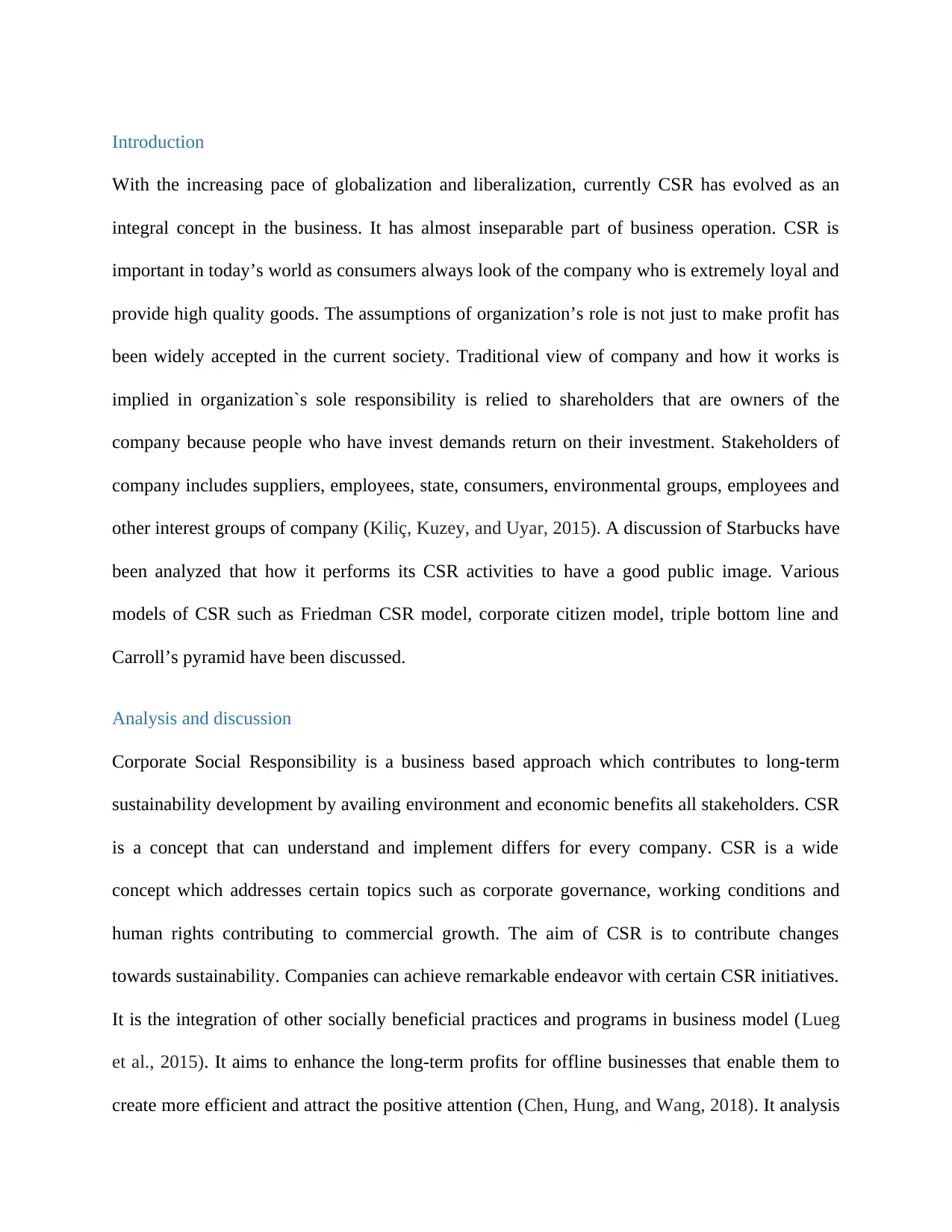
Introduction
With the increasing pace of globalization and liberalization, currently CSR has evolved as an
integral concept in the business. It has almost inseparable part of business operation. CSR is
important in today’s world as consumers always look of the company who is extremely loyal and
provide high quality goods. The assumptions of organization’s role is not just to make profit has
been widely accepted in the current society. Traditional view of company and how it works is
implied in organization`s sole responsibility is relied to shareholders that are owners of the
company because people who have invest demands return on their investment. Stakeholders of
company includes suppliers, employees, state, consumers, environmental groups, employees and
other interest groups of company (Kiliç, Kuzey, and Uyar, 2015). A discussion of Starbucks have
been analyzed that how it performs its CSR activities to have a good public image. Various
models of CSR such as Friedman CSR model, corporate citizen model, triple bottom line and
Carroll’s pyramid have been discussed.
Analysis and discussion
Corporate Social Responsibility is a business based approach which contributes to long-term
sustainability development by availing environment and economic benefits all stakeholders. CSR
is a concept that can understand and implement differs for every company. CSR is a wide
concept which addresses certain topics such as corporate governance, working conditions and
human rights contributing to commercial growth. The aim of CSR is to contribute changes
towards sustainability. Companies can achieve remarkable endeavor with certain CSR initiatives.
It is the integration of other socially beneficial practices and programs in business model (Lueg
et al., 2015). It aims to enhance the long-term profits for offline businesses that enable them to
create more efficient and attract the positive attention (Chen, Hung, and Wang, 2018). It analysis
With the increasing pace of globalization and liberalization, currently CSR has evolved as an
integral concept in the business. It has almost inseparable part of business operation. CSR is
important in today’s world as consumers always look of the company who is extremely loyal and
provide high quality goods. The assumptions of organization’s role is not just to make profit has
been widely accepted in the current society. Traditional view of company and how it works is
implied in organization`s sole responsibility is relied to shareholders that are owners of the
company because people who have invest demands return on their investment. Stakeholders of
company includes suppliers, employees, state, consumers, environmental groups, employees and
other interest groups of company (Kiliç, Kuzey, and Uyar, 2015). A discussion of Starbucks have
been analyzed that how it performs its CSR activities to have a good public image. Various
models of CSR such as Friedman CSR model, corporate citizen model, triple bottom line and
Carroll’s pyramid have been discussed.
Analysis and discussion
Corporate Social Responsibility is a business based approach which contributes to long-term
sustainability development by availing environment and economic benefits all stakeholders. CSR
is a concept that can understand and implement differs for every company. CSR is a wide
concept which addresses certain topics such as corporate governance, working conditions and
human rights contributing to commercial growth. The aim of CSR is to contribute changes
towards sustainability. Companies can achieve remarkable endeavor with certain CSR initiatives.
It is the integration of other socially beneficial practices and programs in business model (Lueg
et al., 2015). It aims to enhance the long-term profits for offline businesses that enable them to
create more efficient and attract the positive attention (Chen, Hung, and Wang, 2018). It analysis
Paraphrase This Document
Need a fresh take? Get an instant paraphrase of this document with our AI Paraphraser
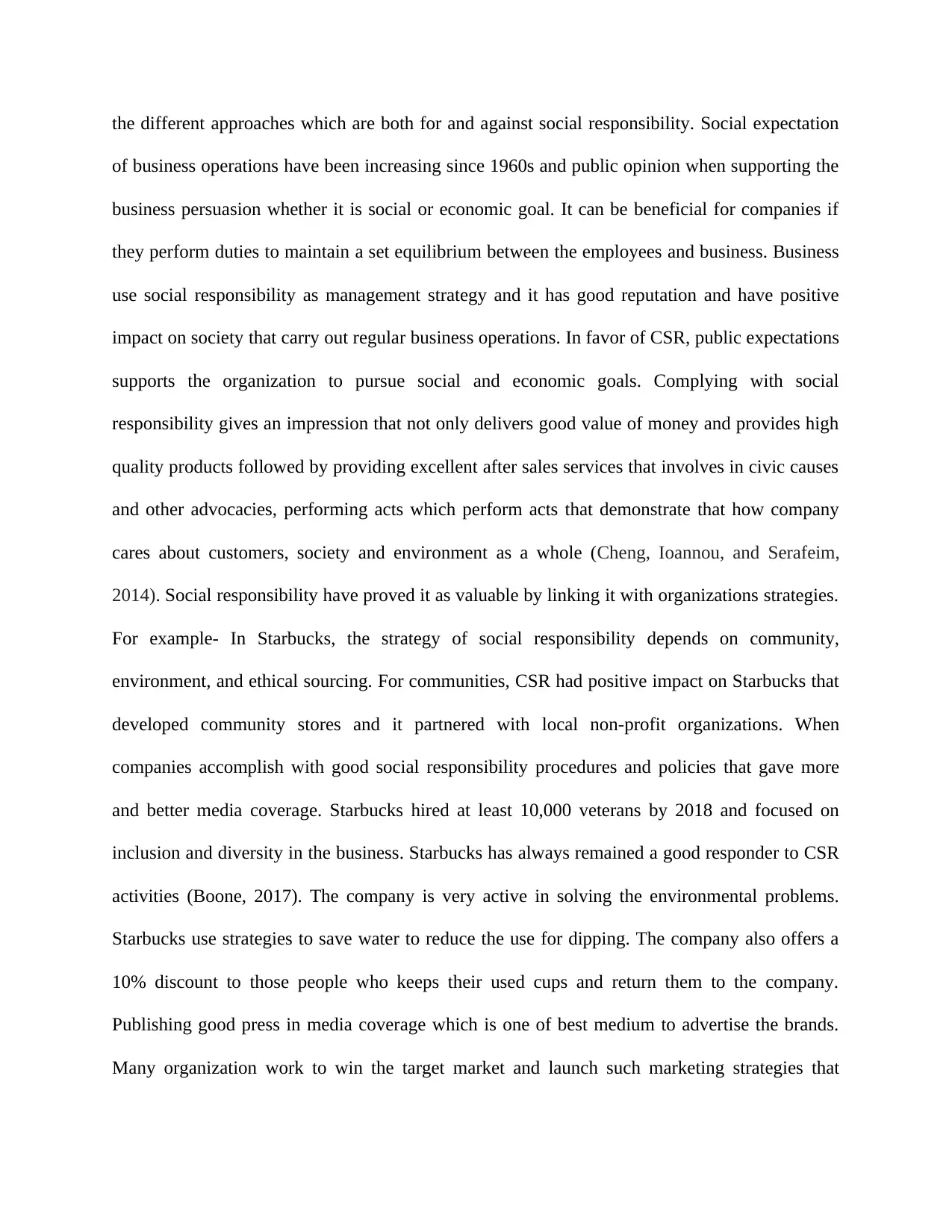
the different approaches which are both for and against social responsibility. Social expectation
of business operations have been increasing since 1960s and public opinion when supporting the
business persuasion whether it is social or economic goal. It can be beneficial for companies if
they perform duties to maintain a set equilibrium between the employees and business. Business
use social responsibility as management strategy and it has good reputation and have positive
impact on society that carry out regular business operations. In favor of CSR, public expectations
supports the organization to pursue social and economic goals. Complying with social
responsibility gives an impression that not only delivers good value of money and provides high
quality products followed by providing excellent after sales services that involves in civic causes
and other advocacies, performing acts which perform acts that demonstrate that how company
cares about customers, society and environment as a whole (Cheng, Ioannou, and Serafeim,
2014). Social responsibility have proved it as valuable by linking it with organizations strategies.
For example- In Starbucks, the strategy of social responsibility depends on community,
environment, and ethical sourcing. For communities, CSR had positive impact on Starbucks that
developed community stores and it partnered with local non-profit organizations. When
companies accomplish with good social responsibility procedures and policies that gave more
and better media coverage. Starbucks hired at least 10,000 veterans by 2018 and focused on
inclusion and diversity in the business. Starbucks has always remained a good responder to CSR
activities (Boone, 2017). The company is very active in solving the environmental problems.
Starbucks use strategies to save water to reduce the use for dipping. The company also offers a
10% discount to those people who keeps their used cups and return them to the company.
Publishing good press in media coverage which is one of best medium to advertise the brands.
Many organization work to win the target market and launch such marketing strategies that
of business operations have been increasing since 1960s and public opinion when supporting the
business persuasion whether it is social or economic goal. It can be beneficial for companies if
they perform duties to maintain a set equilibrium between the employees and business. Business
use social responsibility as management strategy and it has good reputation and have positive
impact on society that carry out regular business operations. In favor of CSR, public expectations
supports the organization to pursue social and economic goals. Complying with social
responsibility gives an impression that not only delivers good value of money and provides high
quality products followed by providing excellent after sales services that involves in civic causes
and other advocacies, performing acts which perform acts that demonstrate that how company
cares about customers, society and environment as a whole (Cheng, Ioannou, and Serafeim,
2014). Social responsibility have proved it as valuable by linking it with organizations strategies.
For example- In Starbucks, the strategy of social responsibility depends on community,
environment, and ethical sourcing. For communities, CSR had positive impact on Starbucks that
developed community stores and it partnered with local non-profit organizations. When
companies accomplish with good social responsibility procedures and policies that gave more
and better media coverage. Starbucks hired at least 10,000 veterans by 2018 and focused on
inclusion and diversity in the business. Starbucks has always remained a good responder to CSR
activities (Boone, 2017). The company is very active in solving the environmental problems.
Starbucks use strategies to save water to reduce the use for dipping. The company also offers a
10% discount to those people who keeps their used cups and return them to the company.
Publishing good press in media coverage which is one of best medium to advertise the brands.
Many organization work to win the target market and launch such marketing strategies that
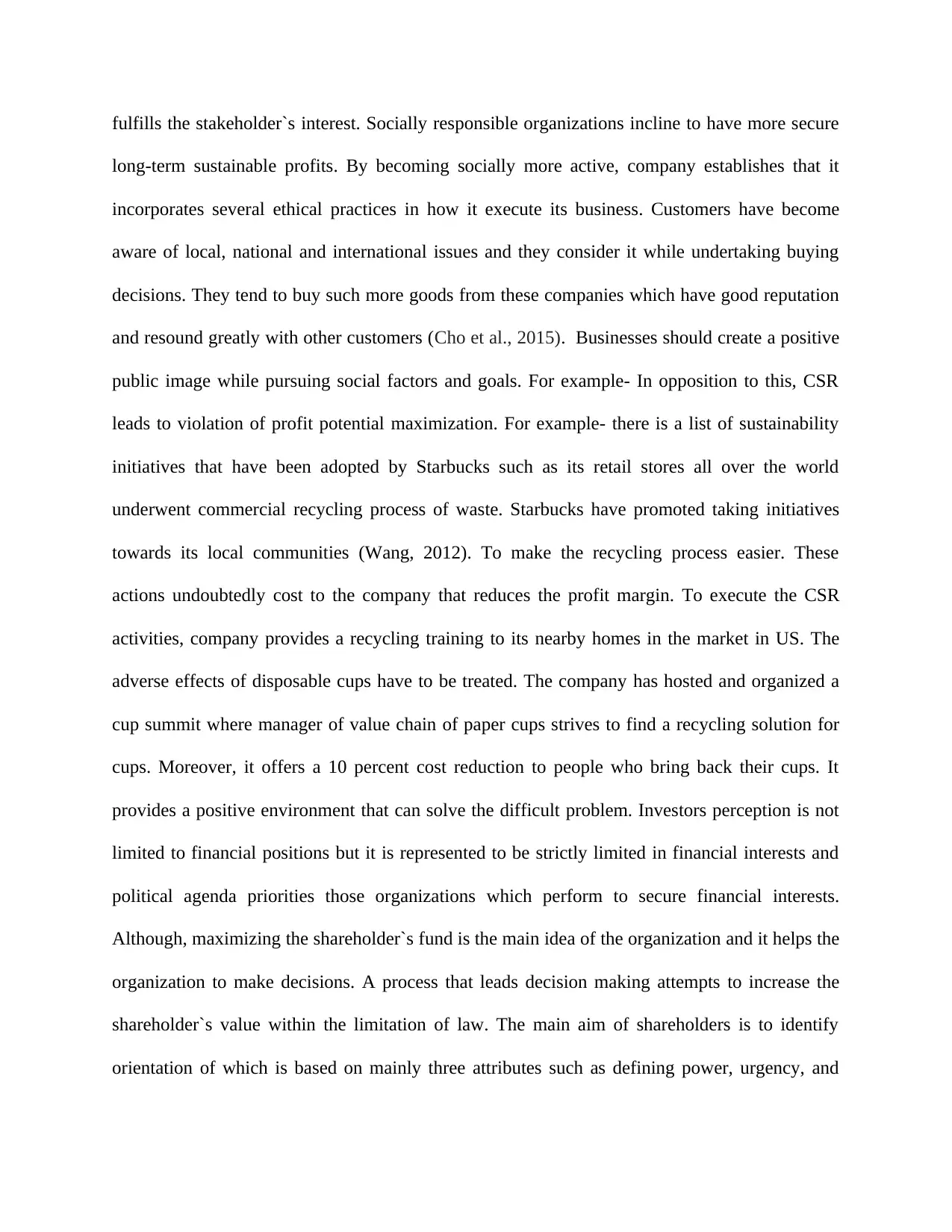
fulfills the stakeholder`s interest. Socially responsible organizations incline to have more secure
long-term sustainable profits. By becoming socially more active, company establishes that it
incorporates several ethical practices in how it execute its business. Customers have become
aware of local, national and international issues and they consider it while undertaking buying
decisions. They tend to buy such more goods from these companies which have good reputation
and resound greatly with other customers (Cho et al., 2015). Businesses should create a positive
public image while pursuing social factors and goals. For example- In opposition to this, CSR
leads to violation of profit potential maximization. For example- there is a list of sustainability
initiatives that have been adopted by Starbucks such as its retail stores all over the world
underwent commercial recycling process of waste. Starbucks have promoted taking initiatives
towards its local communities (Wang, 2012). To make the recycling process easier. These
actions undoubtedly cost to the company that reduces the profit margin. To execute the CSR
activities, company provides a recycling training to its nearby homes in the market in US. The
adverse effects of disposable cups have to be treated. The company has hosted and organized a
cup summit where manager of value chain of paper cups strives to find a recycling solution for
cups. Moreover, it offers a 10 percent cost reduction to people who bring back their cups. It
provides a positive environment that can solve the difficult problem. Investors perception is not
limited to financial positions but it is represented to be strictly limited in financial interests and
political agenda priorities those organizations which perform to secure financial interests.
Although, maximizing the shareholder`s fund is the main idea of the organization and it helps the
organization to make decisions. A process that leads decision making attempts to increase the
shareholder`s value within the limitation of law. The main aim of shareholders is to identify
orientation of which is based on mainly three attributes such as defining power, urgency, and
long-term sustainable profits. By becoming socially more active, company establishes that it
incorporates several ethical practices in how it execute its business. Customers have become
aware of local, national and international issues and they consider it while undertaking buying
decisions. They tend to buy such more goods from these companies which have good reputation
and resound greatly with other customers (Cho et al., 2015). Businesses should create a positive
public image while pursuing social factors and goals. For example- In opposition to this, CSR
leads to violation of profit potential maximization. For example- there is a list of sustainability
initiatives that have been adopted by Starbucks such as its retail stores all over the world
underwent commercial recycling process of waste. Starbucks have promoted taking initiatives
towards its local communities (Wang, 2012). To make the recycling process easier. These
actions undoubtedly cost to the company that reduces the profit margin. To execute the CSR
activities, company provides a recycling training to its nearby homes in the market in US. The
adverse effects of disposable cups have to be treated. The company has hosted and organized a
cup summit where manager of value chain of paper cups strives to find a recycling solution for
cups. Moreover, it offers a 10 percent cost reduction to people who bring back their cups. It
provides a positive environment that can solve the difficult problem. Investors perception is not
limited to financial positions but it is represented to be strictly limited in financial interests and
political agenda priorities those organizations which perform to secure financial interests.
Although, maximizing the shareholder`s fund is the main idea of the organization and it helps the
organization to make decisions. A process that leads decision making attempts to increase the
shareholder`s value within the limitation of law. The main aim of shareholders is to identify
orientation of which is based on mainly three attributes such as defining power, urgency, and
⊘ This is a preview!⊘
Do you want full access?
Subscribe today to unlock all pages.

Trusted by 1+ million students worldwide
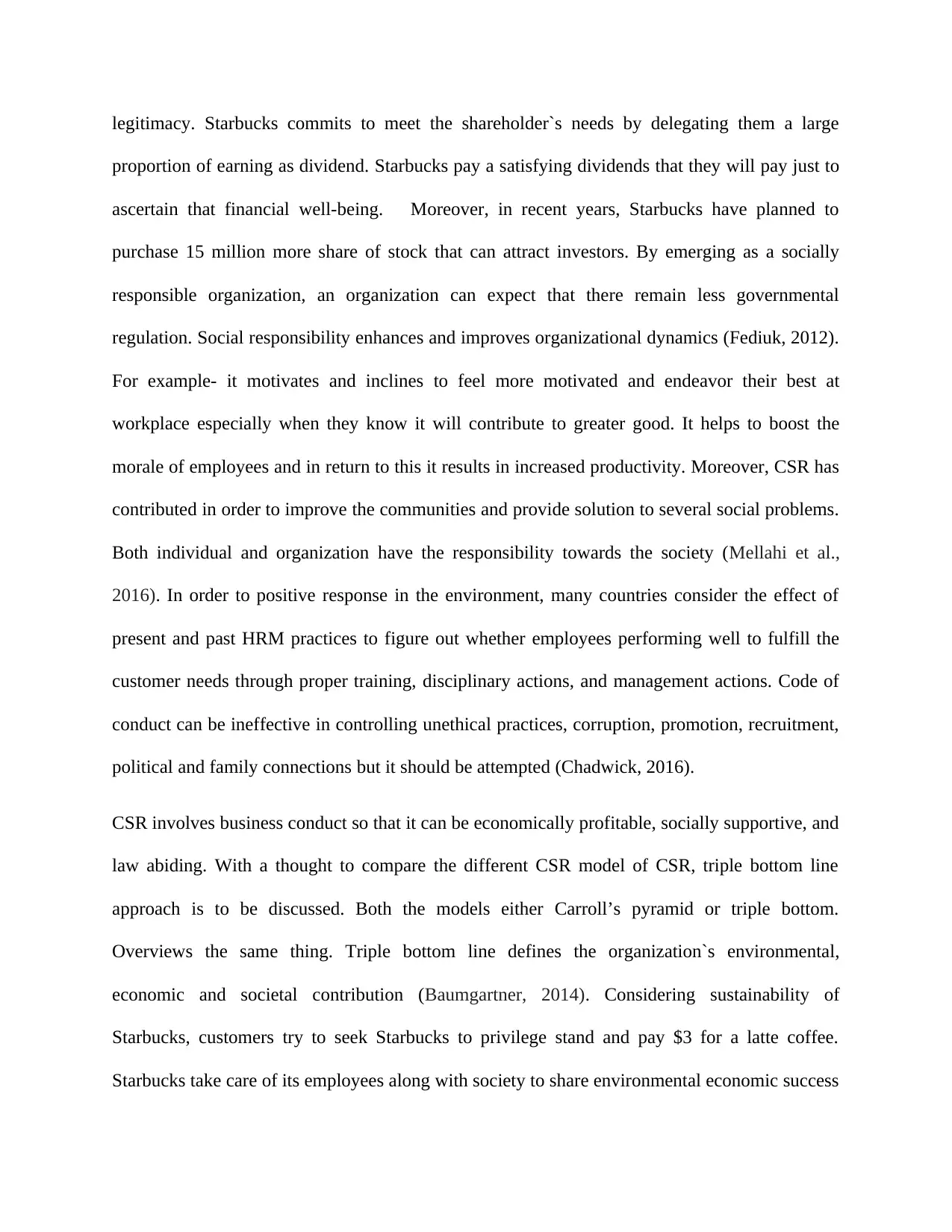
legitimacy. Starbucks commits to meet the shareholder`s needs by delegating them a large
proportion of earning as dividend. Starbucks pay a satisfying dividends that they will pay just to
ascertain that financial well-being. Moreover, in recent years, Starbucks have planned to
purchase 15 million more share of stock that can attract investors. By emerging as a socially
responsible organization, an organization can expect that there remain less governmental
regulation. Social responsibility enhances and improves organizational dynamics (Fediuk, 2012).
For example- it motivates and inclines to feel more motivated and endeavor their best at
workplace especially when they know it will contribute to greater good. It helps to boost the
morale of employees and in return to this it results in increased productivity. Moreover, CSR has
contributed in order to improve the communities and provide solution to several social problems.
Both individual and organization have the responsibility towards the society (Mellahi et al.,
2016). In order to positive response in the environment, many countries consider the effect of
present and past HRM practices to figure out whether employees performing well to fulfill the
customer needs through proper training, disciplinary actions, and management actions. Code of
conduct can be ineffective in controlling unethical practices, corruption, promotion, recruitment,
political and family connections but it should be attempted (Chadwick, 2016).
CSR involves business conduct so that it can be economically profitable, socially supportive, and
law abiding. With a thought to compare the different CSR model of CSR, triple bottom line
approach is to be discussed. Both the models either Carroll’s pyramid or triple bottom.
Overviews the same thing. Triple bottom line defines the organization`s environmental,
economic and societal contribution (Baumgartner, 2014). Considering sustainability of
Starbucks, customers try to seek Starbucks to privilege stand and pay $3 for a latte coffee.
Starbucks take care of its employees along with society to share environmental economic success
proportion of earning as dividend. Starbucks pay a satisfying dividends that they will pay just to
ascertain that financial well-being. Moreover, in recent years, Starbucks have planned to
purchase 15 million more share of stock that can attract investors. By emerging as a socially
responsible organization, an organization can expect that there remain less governmental
regulation. Social responsibility enhances and improves organizational dynamics (Fediuk, 2012).
For example- it motivates and inclines to feel more motivated and endeavor their best at
workplace especially when they know it will contribute to greater good. It helps to boost the
morale of employees and in return to this it results in increased productivity. Moreover, CSR has
contributed in order to improve the communities and provide solution to several social problems.
Both individual and organization have the responsibility towards the society (Mellahi et al.,
2016). In order to positive response in the environment, many countries consider the effect of
present and past HRM practices to figure out whether employees performing well to fulfill the
customer needs through proper training, disciplinary actions, and management actions. Code of
conduct can be ineffective in controlling unethical practices, corruption, promotion, recruitment,
political and family connections but it should be attempted (Chadwick, 2016).
CSR involves business conduct so that it can be economically profitable, socially supportive, and
law abiding. With a thought to compare the different CSR model of CSR, triple bottom line
approach is to be discussed. Both the models either Carroll’s pyramid or triple bottom.
Overviews the same thing. Triple bottom line defines the organization`s environmental,
economic and societal contribution (Baumgartner, 2014). Considering sustainability of
Starbucks, customers try to seek Starbucks to privilege stand and pay $3 for a latte coffee.
Starbucks take care of its employees along with society to share environmental economic success
Paraphrase This Document
Need a fresh take? Get an instant paraphrase of this document with our AI Paraphraser
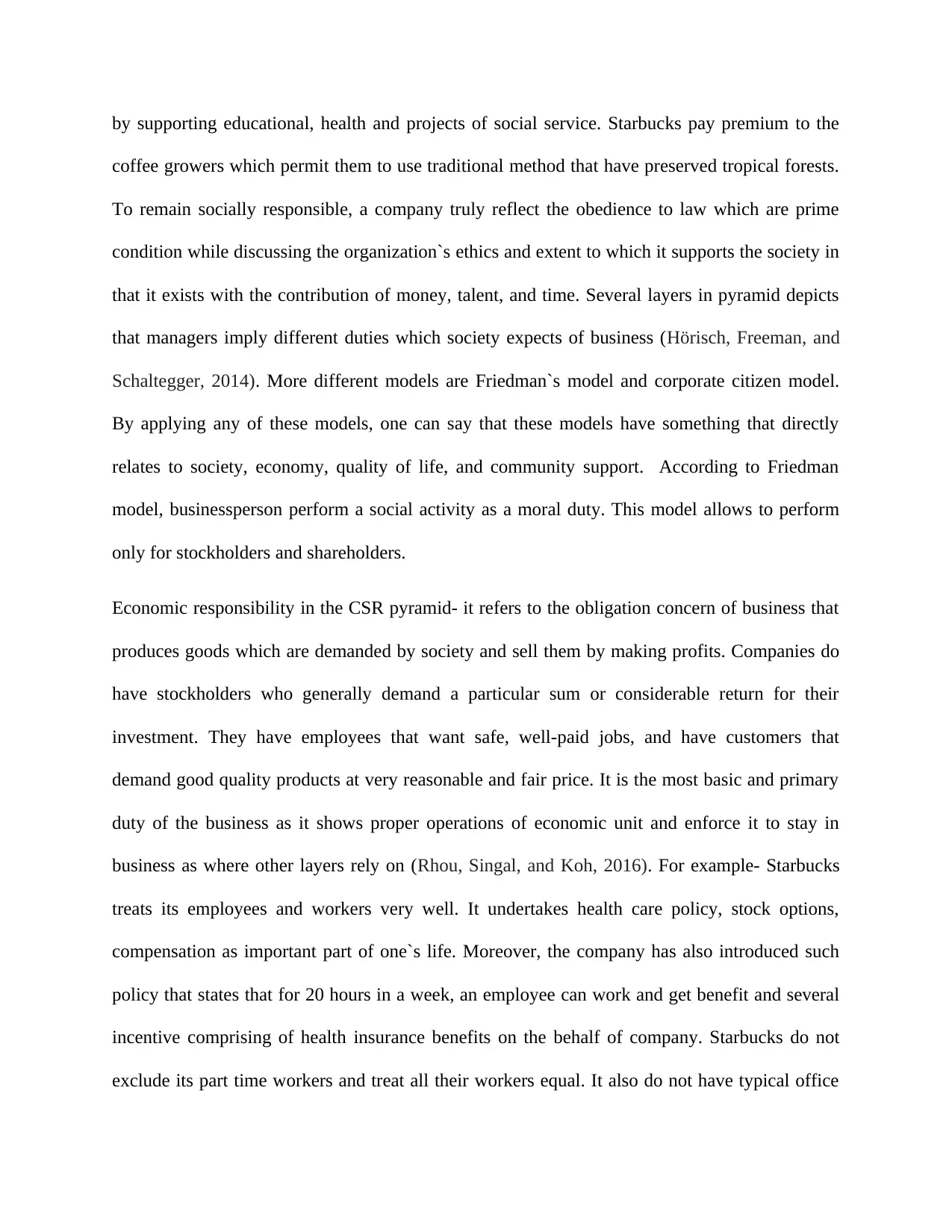
by supporting educational, health and projects of social service. Starbucks pay premium to the
coffee growers which permit them to use traditional method that have preserved tropical forests.
To remain socially responsible, a company truly reflect the obedience to law which are prime
condition while discussing the organization`s ethics and extent to which it supports the society in
that it exists with the contribution of money, talent, and time. Several layers in pyramid depicts
that managers imply different duties which society expects of business (Hörisch, Freeman, and
Schaltegger, 2014). More different models are Friedman`s model and corporate citizen model.
By applying any of these models, one can say that these models have something that directly
relates to society, economy, quality of life, and community support. According to Friedman
model, businessperson perform a social activity as a moral duty. This model allows to perform
only for stockholders and shareholders.
Economic responsibility in the CSR pyramid- it refers to the obligation concern of business that
produces goods which are demanded by society and sell them by making profits. Companies do
have stockholders who generally demand a particular sum or considerable return for their
investment. They have employees that want safe, well-paid jobs, and have customers that
demand good quality products at very reasonable and fair price. It is the most basic and primary
duty of the business as it shows proper operations of economic unit and enforce it to stay in
business as where other layers rely on (Rhou, Singal, and Koh, 2016). For example- Starbucks
treats its employees and workers very well. It undertakes health care policy, stock options,
compensation as important part of one`s life. Moreover, the company has also introduced such
policy that states that for 20 hours in a week, an employee can work and get benefit and several
incentive comprising of health insurance benefits on the behalf of company. Starbucks do not
exclude its part time workers and treat all their workers equal. It also do not have typical office
coffee growers which permit them to use traditional method that have preserved tropical forests.
To remain socially responsible, a company truly reflect the obedience to law which are prime
condition while discussing the organization`s ethics and extent to which it supports the society in
that it exists with the contribution of money, talent, and time. Several layers in pyramid depicts
that managers imply different duties which society expects of business (Hörisch, Freeman, and
Schaltegger, 2014). More different models are Friedman`s model and corporate citizen model.
By applying any of these models, one can say that these models have something that directly
relates to society, economy, quality of life, and community support. According to Friedman
model, businessperson perform a social activity as a moral duty. This model allows to perform
only for stockholders and shareholders.
Economic responsibility in the CSR pyramid- it refers to the obligation concern of business that
produces goods which are demanded by society and sell them by making profits. Companies do
have stockholders who generally demand a particular sum or considerable return for their
investment. They have employees that want safe, well-paid jobs, and have customers that
demand good quality products at very reasonable and fair price. It is the most basic and primary
duty of the business as it shows proper operations of economic unit and enforce it to stay in
business as where other layers rely on (Rhou, Singal, and Koh, 2016). For example- Starbucks
treats its employees and workers very well. It undertakes health care policy, stock options,
compensation as important part of one`s life. Moreover, the company has also introduced such
policy that states that for 20 hours in a week, an employee can work and get benefit and several
incentive comprising of health insurance benefits on the behalf of company. Starbucks do not
exclude its part time workers and treat all their workers equal. It also do not have typical office
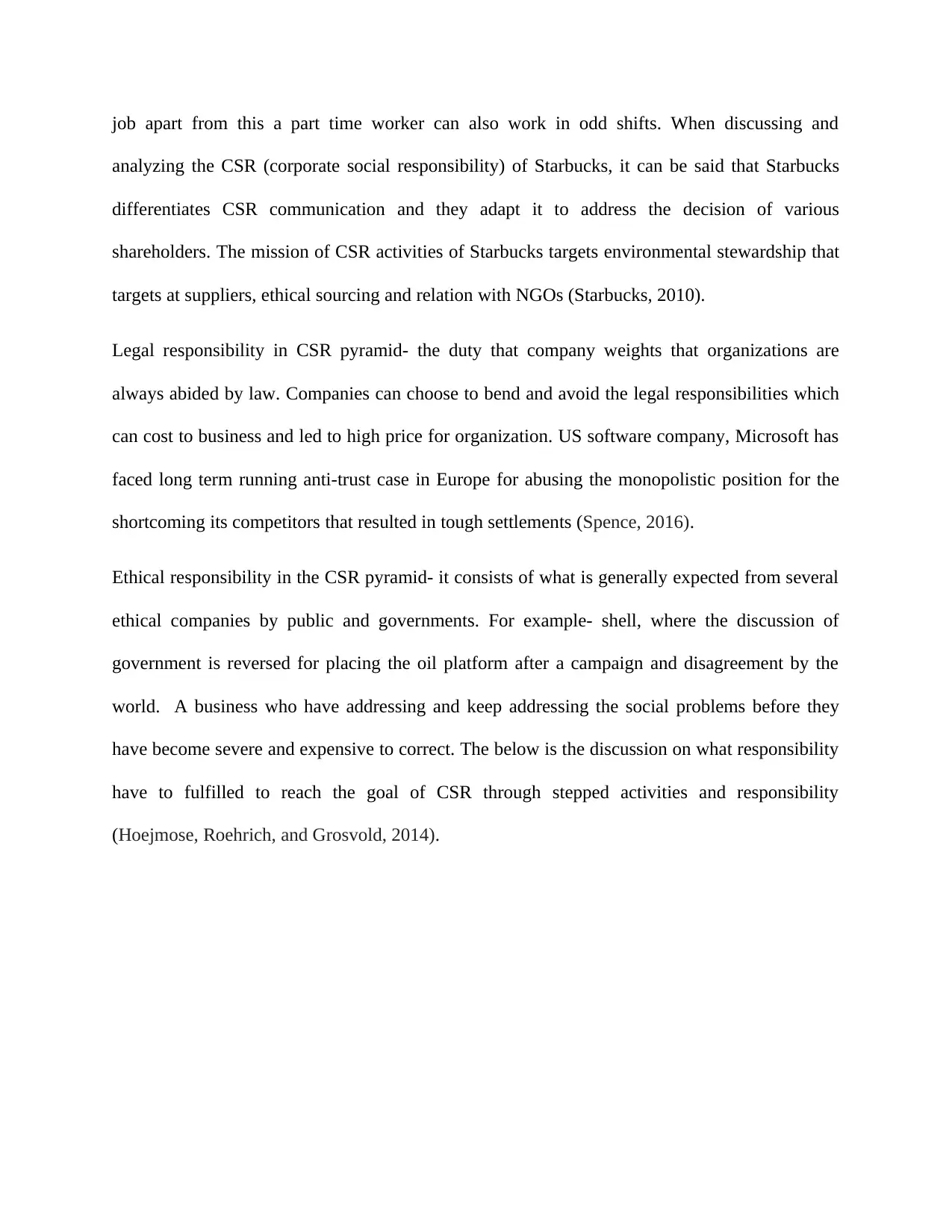
job apart from this a part time worker can also work in odd shifts. When discussing and
analyzing the CSR (corporate social responsibility) of Starbucks, it can be said that Starbucks
differentiates CSR communication and they adapt it to address the decision of various
shareholders. The mission of CSR activities of Starbucks targets environmental stewardship that
targets at suppliers, ethical sourcing and relation with NGOs (Starbucks, 2010).
Legal responsibility in CSR pyramid- the duty that company weights that organizations are
always abided by law. Companies can choose to bend and avoid the legal responsibilities which
can cost to business and led to high price for organization. US software company, Microsoft has
faced long term running anti-trust case in Europe for abusing the monopolistic position for the
shortcoming its competitors that resulted in tough settlements (Spence, 2016).
Ethical responsibility in the CSR pyramid- it consists of what is generally expected from several
ethical companies by public and governments. For example- shell, where the discussion of
government is reversed for placing the oil platform after a campaign and disagreement by the
world. A business who have addressing and keep addressing the social problems before they
have become severe and expensive to correct. The below is the discussion on what responsibility
have to fulfilled to reach the goal of CSR through stepped activities and responsibility
(Hoejmose, Roehrich, and Grosvold, 2014).
analyzing the CSR (corporate social responsibility) of Starbucks, it can be said that Starbucks
differentiates CSR communication and they adapt it to address the decision of various
shareholders. The mission of CSR activities of Starbucks targets environmental stewardship that
targets at suppliers, ethical sourcing and relation with NGOs (Starbucks, 2010).
Legal responsibility in CSR pyramid- the duty that company weights that organizations are
always abided by law. Companies can choose to bend and avoid the legal responsibilities which
can cost to business and led to high price for organization. US software company, Microsoft has
faced long term running anti-trust case in Europe for abusing the monopolistic position for the
shortcoming its competitors that resulted in tough settlements (Spence, 2016).
Ethical responsibility in the CSR pyramid- it consists of what is generally expected from several
ethical companies by public and governments. For example- shell, where the discussion of
government is reversed for placing the oil platform after a campaign and disagreement by the
world. A business who have addressing and keep addressing the social problems before they
have become severe and expensive to correct. The below is the discussion on what responsibility
have to fulfilled to reach the goal of CSR through stepped activities and responsibility
(Hoejmose, Roehrich, and Grosvold, 2014).
⊘ This is a preview!⊘
Do you want full access?
Subscribe today to unlock all pages.

Trusted by 1+ million students worldwide
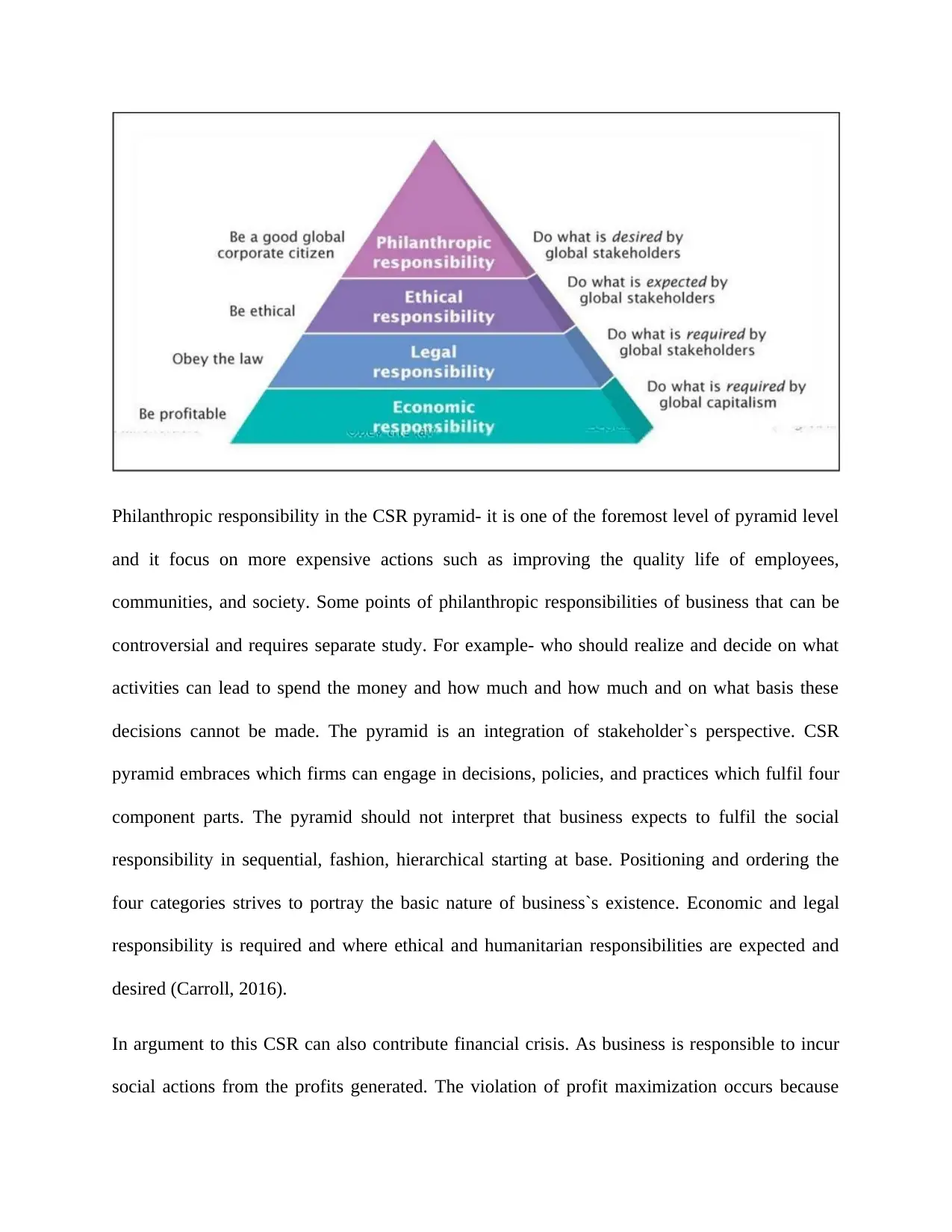
Philanthropic responsibility in the CSR pyramid- it is one of the foremost level of pyramid level
and it focus on more expensive actions such as improving the quality life of employees,
communities, and society. Some points of philanthropic responsibilities of business that can be
controversial and requires separate study. For example- who should realize and decide on what
activities can lead to spend the money and how much and how much and on what basis these
decisions cannot be made. The pyramid is an integration of stakeholder`s perspective. CSR
pyramid embraces which firms can engage in decisions, policies, and practices which fulfil four
component parts. The pyramid should not interpret that business expects to fulfil the social
responsibility in sequential, fashion, hierarchical starting at base. Positioning and ordering the
four categories strives to portray the basic nature of business`s existence. Economic and legal
responsibility is required and where ethical and humanitarian responsibilities are expected and
desired (Carroll, 2016).
In argument to this CSR can also contribute financial crisis. As business is responsible to incur
social actions from the profits generated. The violation of profit maximization occurs because
and it focus on more expensive actions such as improving the quality life of employees,
communities, and society. Some points of philanthropic responsibilities of business that can be
controversial and requires separate study. For example- who should realize and decide on what
activities can lead to spend the money and how much and how much and on what basis these
decisions cannot be made. The pyramid is an integration of stakeholder`s perspective. CSR
pyramid embraces which firms can engage in decisions, policies, and practices which fulfil four
component parts. The pyramid should not interpret that business expects to fulfil the social
responsibility in sequential, fashion, hierarchical starting at base. Positioning and ordering the
four categories strives to portray the basic nature of business`s existence. Economic and legal
responsibility is required and where ethical and humanitarian responsibilities are expected and
desired (Carroll, 2016).
In argument to this CSR can also contribute financial crisis. As business is responsible to incur
social actions from the profits generated. The violation of profit maximization occurs because
Paraphrase This Document
Need a fresh take? Get an instant paraphrase of this document with our AI Paraphraser
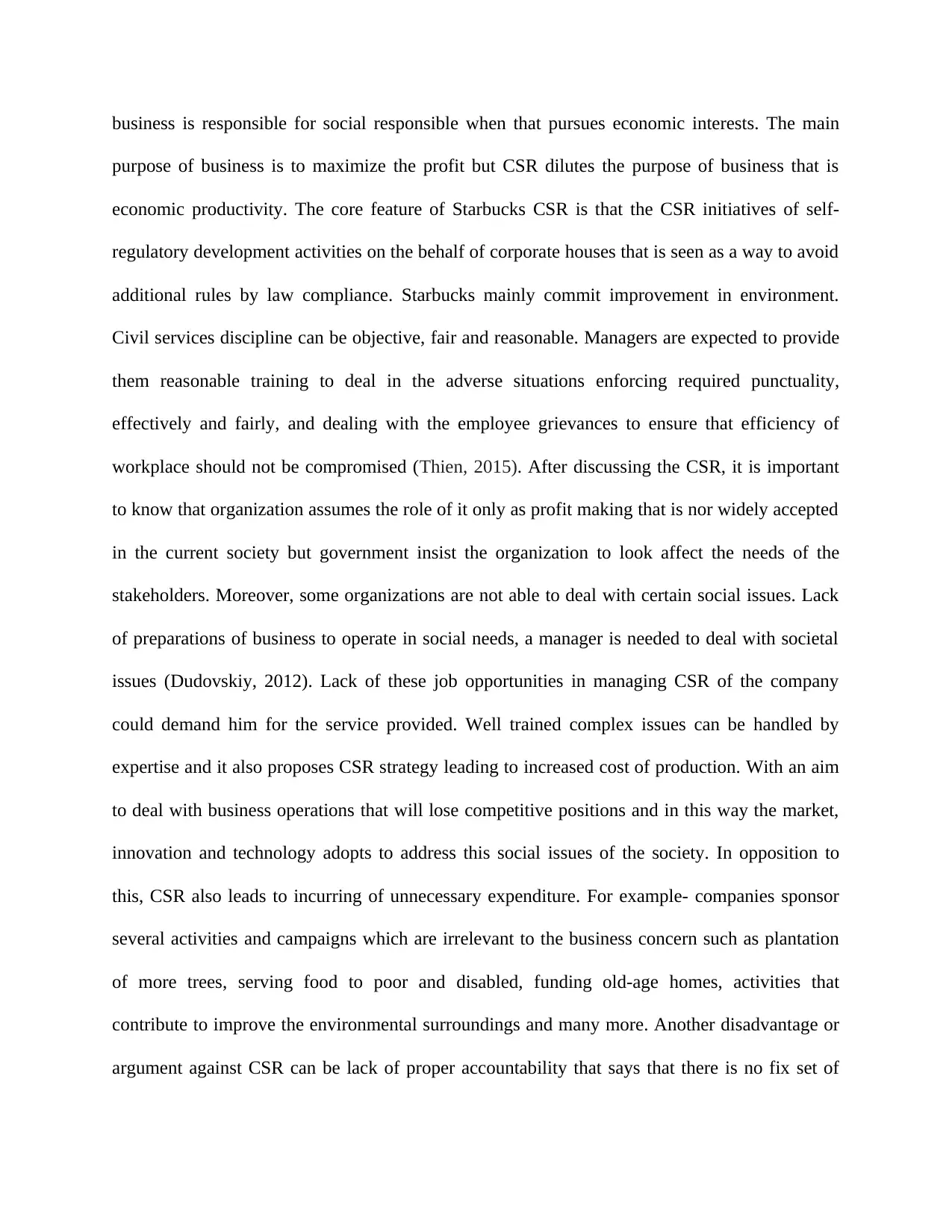
business is responsible for social responsible when that pursues economic interests. The main
purpose of business is to maximize the profit but CSR dilutes the purpose of business that is
economic productivity. The core feature of Starbucks CSR is that the CSR initiatives of self-
regulatory development activities on the behalf of corporate houses that is seen as a way to avoid
additional rules by law compliance. Starbucks mainly commit improvement in environment.
Civil services discipline can be objective, fair and reasonable. Managers are expected to provide
them reasonable training to deal in the adverse situations enforcing required punctuality,
effectively and fairly, and dealing with the employee grievances to ensure that efficiency of
workplace should not be compromised (Thien, 2015). After discussing the CSR, it is important
to know that organization assumes the role of it only as profit making that is nor widely accepted
in the current society but government insist the organization to look affect the needs of the
stakeholders. Moreover, some organizations are not able to deal with certain social issues. Lack
of preparations of business to operate in social needs, a manager is needed to deal with societal
issues (Dudovskiy, 2012). Lack of these job opportunities in managing CSR of the company
could demand him for the service provided. Well trained complex issues can be handled by
expertise and it also proposes CSR strategy leading to increased cost of production. With an aim
to deal with business operations that will lose competitive positions and in this way the market,
innovation and technology adopts to address this social issues of the society. In opposition to
this, CSR also leads to incurring of unnecessary expenditure. For example- companies sponsor
several activities and campaigns which are irrelevant to the business concern such as plantation
of more trees, serving food to poor and disabled, funding old-age homes, activities that
contribute to improve the environmental surroundings and many more. Another disadvantage or
argument against CSR can be lack of proper accountability that says that there is no fix set of
purpose of business is to maximize the profit but CSR dilutes the purpose of business that is
economic productivity. The core feature of Starbucks CSR is that the CSR initiatives of self-
regulatory development activities on the behalf of corporate houses that is seen as a way to avoid
additional rules by law compliance. Starbucks mainly commit improvement in environment.
Civil services discipline can be objective, fair and reasonable. Managers are expected to provide
them reasonable training to deal in the adverse situations enforcing required punctuality,
effectively and fairly, and dealing with the employee grievances to ensure that efficiency of
workplace should not be compromised (Thien, 2015). After discussing the CSR, it is important
to know that organization assumes the role of it only as profit making that is nor widely accepted
in the current society but government insist the organization to look affect the needs of the
stakeholders. Moreover, some organizations are not able to deal with certain social issues. Lack
of preparations of business to operate in social needs, a manager is needed to deal with societal
issues (Dudovskiy, 2012). Lack of these job opportunities in managing CSR of the company
could demand him for the service provided. Well trained complex issues can be handled by
expertise and it also proposes CSR strategy leading to increased cost of production. With an aim
to deal with business operations that will lose competitive positions and in this way the market,
innovation and technology adopts to address this social issues of the society. In opposition to
this, CSR also leads to incurring of unnecessary expenditure. For example- companies sponsor
several activities and campaigns which are irrelevant to the business concern such as plantation
of more trees, serving food to poor and disabled, funding old-age homes, activities that
contribute to improve the environmental surroundings and many more. Another disadvantage or
argument against CSR can be lack of proper accountability that says that there is no fix set of
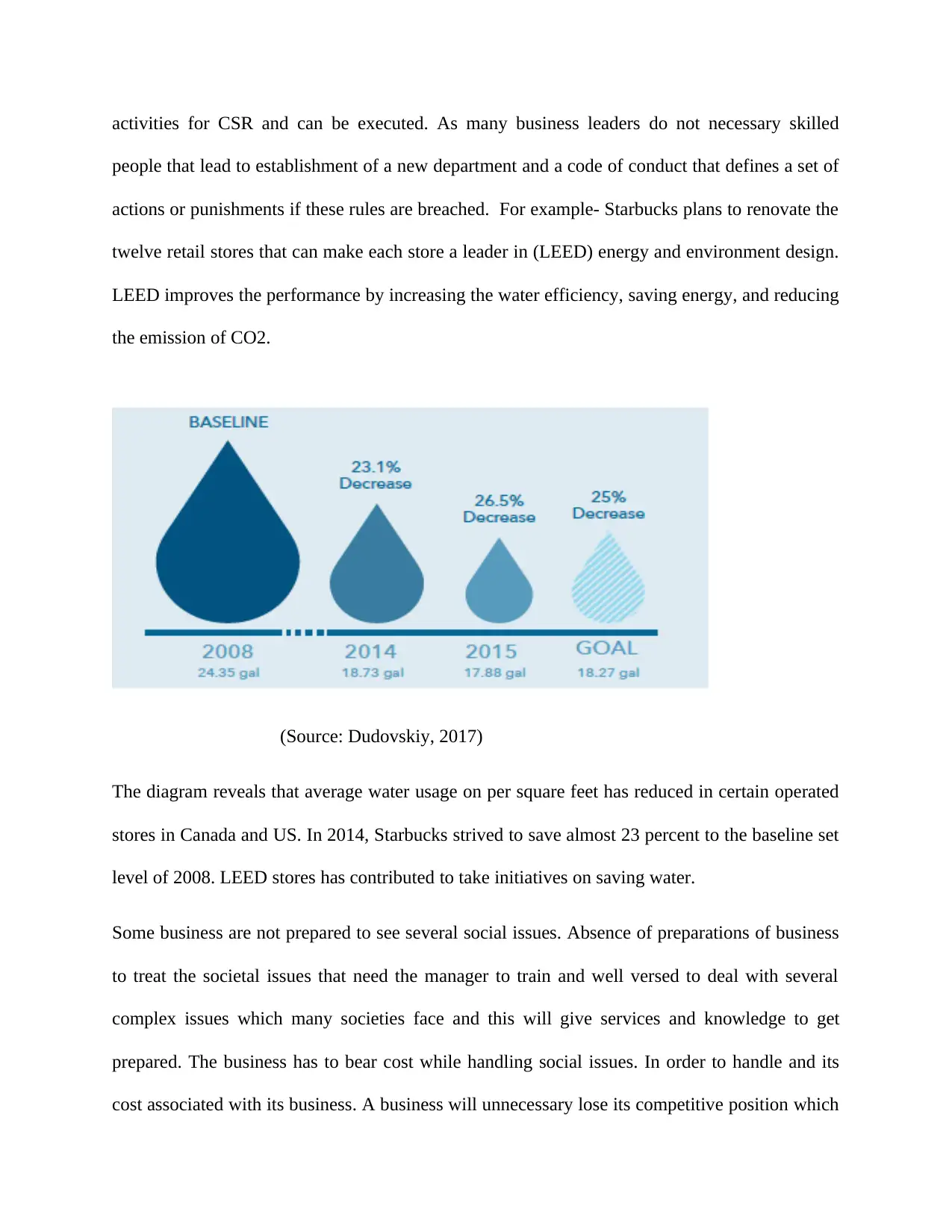
activities for CSR and can be executed. As many business leaders do not necessary skilled
people that lead to establishment of a new department and a code of conduct that defines a set of
actions or punishments if these rules are breached. For example- Starbucks plans to renovate the
twelve retail stores that can make each store a leader in (LEED) energy and environment design.
LEED improves the performance by increasing the water efficiency, saving energy, and reducing
the emission of CO2.
(Source: Dudovskiy, 2017)
The diagram reveals that average water usage on per square feet has reduced in certain operated
stores in Canada and US. In 2014, Starbucks strived to save almost 23 percent to the baseline set
level of 2008. LEED stores has contributed to take initiatives on saving water.
Some business are not prepared to see several social issues. Absence of preparations of business
to treat the societal issues that need the manager to train and well versed to deal with several
complex issues which many societies face and this will give services and knowledge to get
prepared. The business has to bear cost while handling social issues. In order to handle and its
cost associated with its business. A business will unnecessary lose its competitive position which
people that lead to establishment of a new department and a code of conduct that defines a set of
actions or punishments if these rules are breached. For example- Starbucks plans to renovate the
twelve retail stores that can make each store a leader in (LEED) energy and environment design.
LEED improves the performance by increasing the water efficiency, saving energy, and reducing
the emission of CO2.
(Source: Dudovskiy, 2017)
The diagram reveals that average water usage on per square feet has reduced in certain operated
stores in Canada and US. In 2014, Starbucks strived to save almost 23 percent to the baseline set
level of 2008. LEED stores has contributed to take initiatives on saving water.
Some business are not prepared to see several social issues. Absence of preparations of business
to treat the societal issues that need the manager to train and well versed to deal with several
complex issues which many societies face and this will give services and knowledge to get
prepared. The business has to bear cost while handling social issues. In order to handle and its
cost associated with its business. A business will unnecessary lose its competitive position which
⊘ This is a preview!⊘
Do you want full access?
Subscribe today to unlock all pages.

Trusted by 1+ million students worldwide
1 out of 16
Related Documents
Your All-in-One AI-Powered Toolkit for Academic Success.
+13062052269
info@desklib.com
Available 24*7 on WhatsApp / Email
![[object Object]](/_next/static/media/star-bottom.7253800d.svg)
Unlock your academic potential
Copyright © 2020–2025 A2Z Services. All Rights Reserved. Developed and managed by ZUCOL.





